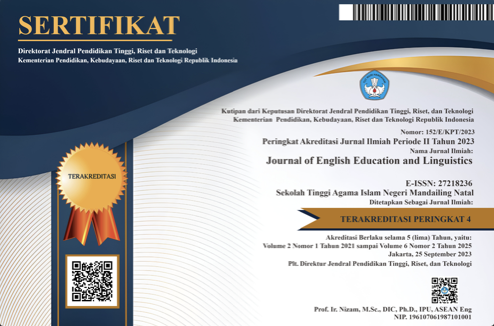Improving Students’ English Writing Proficiency through Interactive Writing Technique
DOI:
https://doi.org/10.56874/jeel.v1i1.50Keywords:
English Writing Proficiency, Interactive Writing, Intervention, EffectivenessAbstract
One of the active skills required not only in the field of academe for students but also in the industry world with degree holder employees that cause predicament in both areas is writing. Writing is one of the hurdles of different companies with their degree holder employees. Similarly, in the context of the academe, it is also found by previous studies that students are coping in writing academic essays and other writing outputs. The study aims to determine the effectiveness of interactive writing technique in intensifying basic writing skills to produce competent employees both in the academe and in the business world. This study also sought to address the predicament of students’ and employees’ low-level proficiency in basic writing. Interactive Writing is a collaborative technique used to enhance the level of proficiency when it comes to the organization of ideas, diction, elaboration, support and writing mechanics. Purposively, using these objectives: To investigate the level of English major’s writing proficiency in pre-test and post-test along with content, mechanics, organization, diction, elaboration, and support; to identify the level of effectiveness of the interactive technique and be able to establish an output based on the research findings. The study used a mixed-method design. Three phases of data gathering procedure were employed namely; pre-test, intervention, and post-test. Pre-test and Post-test were compared using the t-test and analyzed using the Error Density Index of Malicsi (2018). Results of the study unveil that students writing in the post-test improved from the pre-test general weighted mean of 2.28 interpreted as "developing" to 2.58 general weighted mean in the post-test interpreted as "approaching proficiency", indicating that there is an improvement in the writing proficiency of the students after various interventions using the Interactive Writing Technique. Moreover, these results were advertised and employed in producing a teacher and student module to continuously strengthen and amplify student's basic writing skills.
References
Gustilo, L. E. (2016). Differences in Less Proficient and More Proficient ESL College Writing in the Philippine Setting. The Philippines ESL Journal, Vol. 16, 27-45.
Moore, K. (2016, March 31). INC. Retrieved from INC.
moose.com, S. (2016, April ). Study moose.com. Retrieved from Study moose.com.
Graham, S., Harris, K., Capizzi, A. M., & Hebert, M. (2014). ResearchGate. Retrieved from ResearchGate.net: https://www.researchgate.net/publication/278151307_Teaching_writing_to_middle_school_s tudents_A_national_survey
Hall, A. H., Toland, M. D., Grisham-Brown, J., & Graham, S. (2013). Exploring Interactive Writing as an Effective Practice for Increasing Head Start Students‟ Alphabet Knowledge Skills.
Clemson University TigerPrints, 1-20.
Kronenberg, E. (2014). The Advantages and Challenges of Using Interactive Writing in a Writer's Workshop. Westminster College, Westminster College.
Maarof, N., & Murat, M. (2013). Writing Strategies Used by ESL Upper Secondary School Students. International Education Studies, Vol. 6, No. 4, 47-55.
Salahat, H. M. (2014). The Effectiveness of Using Interactive Writing on Developing Writing Skills among 7th Graders and Attitude towards Writing. The Islamic University, Gaza.
Buhisan, A. J. (2016). Interactive Writing: A Small Practice With Big Results,. JFS Publishing Services.
Malicsi, J. (2019). Error Density Index Analysis. Multilingual Bulletin.
Schallert, D., Kleiman, G., & Rubin, A. (2007). Analyses of Differences Between Written and Oral Language. University of Illinois.
Watts-Taffe, S., & Truscott, D. M. (2017). Using What We Know About Language and Literacy Development for ESL Students in the Mainstream Classroom. Retrieved from ERIC: https://eric.ed.gov/?id=EJ598943
Demdam, A. L. (2018). Fator Correlates of Students' Writing Proficiency Towards Development of ESL Worksheets. University of Nueva Caceres.
Singh, C. K., Singh, A. K., Razak, N. Q., & Ravinthar, T. (2017). Grammar Errors Made by ESL Tertiary Students in Writing. English Language Teaching Vol. 20, No. 5, 16-27.
Gustilo, L. E. (2010). "What You Think, Feel and Experience Shape Your Writing": Cognitive, Affective, and Contextual Writing Process in ESESL Writing. The Asia- Pacific Education Researcher, Vol. 19, No. 2, 271-285.
Troia, G. A., & Graham, S. (2003). Effective Writing Instruction Across the Grades: What Every Educational ConsultantShould Know. Journal of Educational and Psychological Consultation, 75-89.
Nik, Y. A., Hamzah, A., & Rafidee, H. (2010). A Comparative Study on the Factors Affecting the Writing Performance. International Journal of Educational Research and Technology, Vol 1 , 54-59.
Pablo, J. C., & Lasaten, R. C. (2018). Writing Difficulties and Quality of Academic Essays of Senior High School Students. Asia Pacific Journal of Multidisciplinary Research, Vol. 6, No. 4, 46-57.
McCutchen, D. (2011). From Novice to Expert: Implications of Language Skills and Writing- Relevant Knowledge for Memory During the Development of Writing Skill, Journal of Writing Research, 51-68.
Burton, J. K., Lockee, B. B., Potter, K. R., Evans, M. A., & Culver, S. M. (2011). Impacts Of Teacher Feedback on ESL/EFL Students Writing. Virginia Polytechnic Institute and State University, Virginia Polytechnic Institute and State University.
Downloads
Published
Issue
Section
License
All articles published in the Journal of English Education and Linguistics are licensed under a Creative Commons Attribution-ShareAlike 4.0 International (CC BY-SA) license. This means anyone is free to copy, transform, or redistribute articles for any lawful purpose in any medium, provided they give appropriate attribution to the original author(s) and Journal of English Education and Linguistics, link to the license, indicate if changes were made, and redistribute any derivative work under the same license.
Copyright on articles is retained by the respective author(s) without restrictions. A non-exclusive license is granted to the Journal of English Education and Linguistics to publish the article and identify itself as its original publisher, along with the commercial right to include the article in a hardcopy issue for sale to libraries and individuals.
Although the conditions of the Creative Commons Attribution-ShareAlike 4.0 International (CC BY-SA) license do not apply to authors (as the copyright holder of your article, you have no restrictions on your rights), by submitting to the Journal of English Education and Linguistics, authors recognize the rights of readers and must grant any third party the right to use their articles to the extent provided by the license.

This work is licensed under a Creative Commons Attribution-ShareAlike 4.0 International License.








